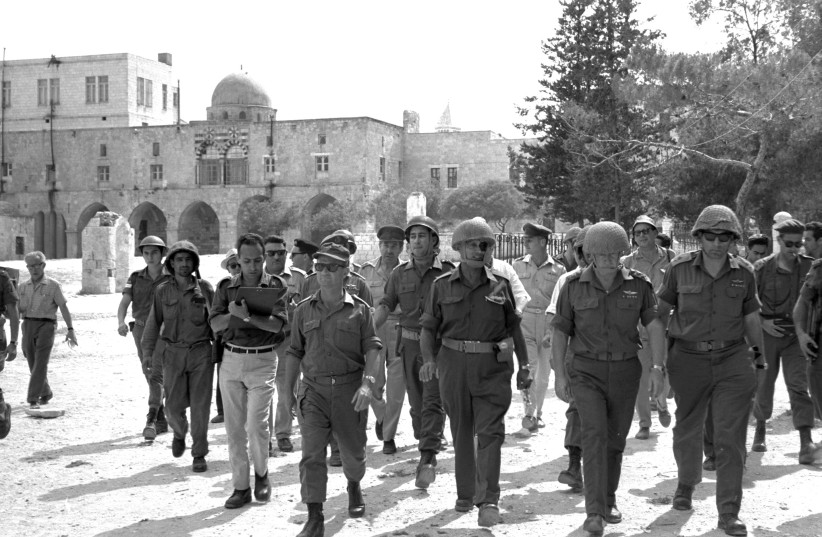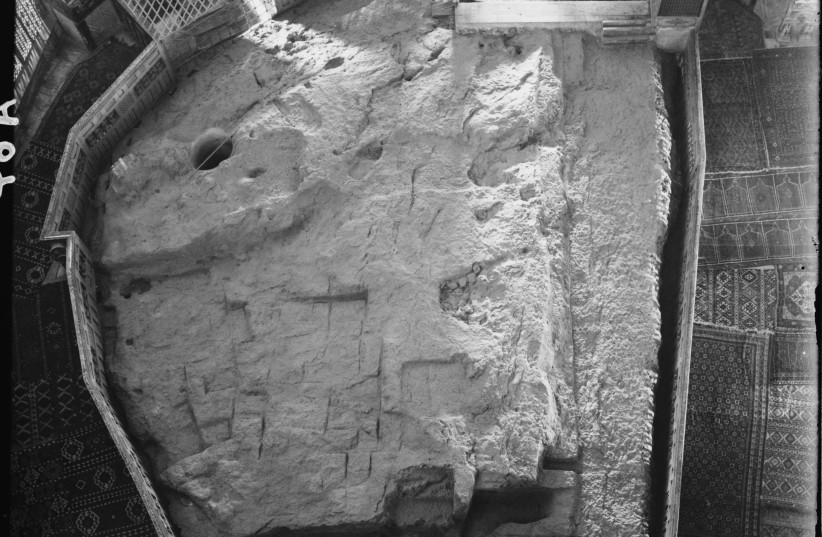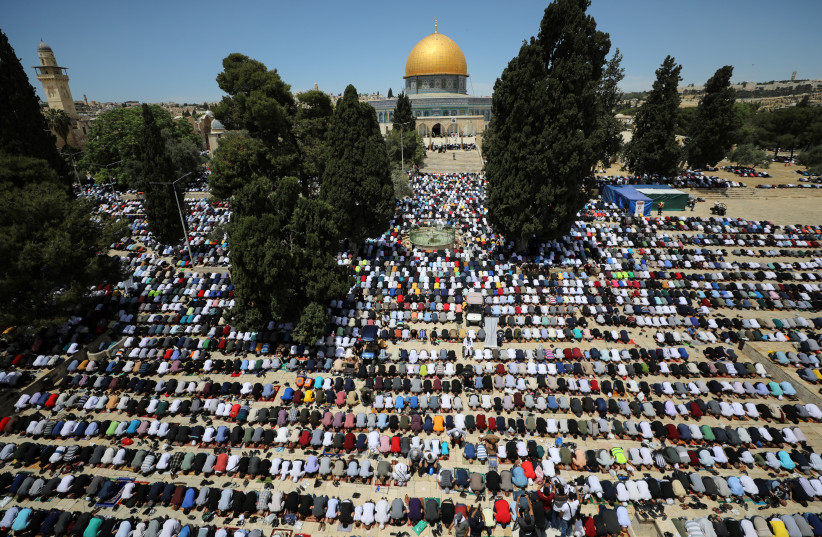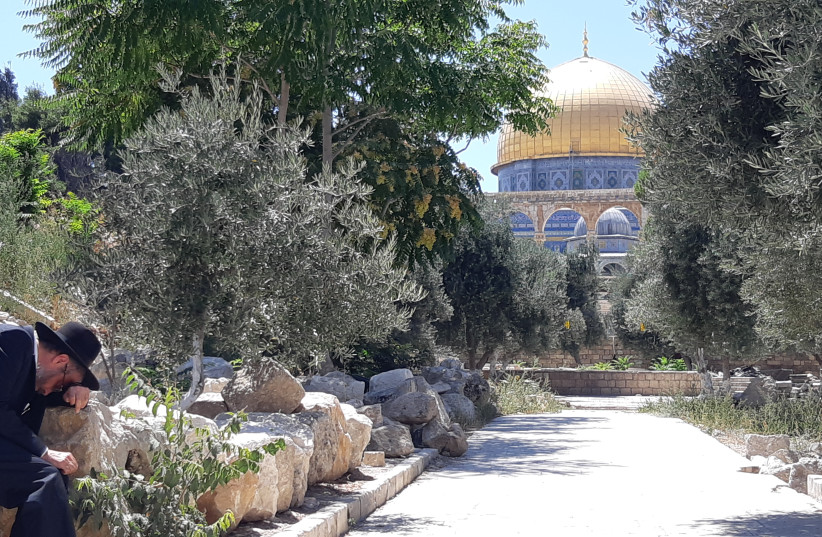On Yom Kippur of 5728, or 1967 of the Common Era, an event took place the likes of which had not been seen for hundreds of years.
A group of 10 men, led by Rabbi Menachem Hacohen – a senior aide to IDF chief Rabbi Shlomo Goren – hadascended to the Temple Mount
at 11 in the morning of Yom Kippur eve and camped out at the site until the fast began at sunset.
In a small building close to al-Aqsa Mosque and the Mugrabi Gate, mattresses were laid out with sleeping bags, and the group of men prayed, slept and prayed again on the holiest day of the year in the Jewish calendar at the holiest site in the world for the Jewish people.
For hundreds of years, since at least the era ofOttoman
rule over Jerusalem, Jewish access to, and prayer at, the Temple Mount had been prohibited – but, Hacohen related, on that Yom Kippur he conducted the full Yom Kippur service, from Kol Nidre in the evening, the Order of the Service the following day and Ne’ila at the end of the fast.
And, once the holy day concluded, he blew the shofar atop the mount.
That Yom Kippur service was the last Jewish prayer service to be conducted on the Temple Mount for over half a century, as defense minister Moshe Dayan went about creating a “status quo” whereby the Wakf Islamic religious trust would administer the site, and only Jewish visitation – not prayer – would be permitted.

‘STATUS QUO’ creator: Defense minister Moshe Dayan (2nd from L.) walks through the Old City during the Six Day War, 1967, accompanied by chief of staff Yitzhak Rabin, Gen. Rehavam Ze’evi and Gen. Uzi Narkiss. (credit: GPO FLICKR)
But today, the situation is much changed. The number of Jewish visitors to the site has increased dramatically over the last five years, and Jewish prayer has returned to the Temple Mount, as first reported by The Jerusalem Post in 2019.
Some 13,800 Jews ascended in 2016, according to Elishama Sandman, chairman of the Yera’eh organization, which encourages Jewish visitation to the site; but by 2019, the last full year before the pandemic, that number had risen to just over 30,000, a spike of nearly 120%.
Increasingly, visiting the Temple Mount has turned from something thought to be the preserve of messianic religious hardliners to a phenomenon that has become much more accepted, both in the religious-Zionist sector and beyond.
This heightened flow of Jewish visitors, together with favorable policies toward such visitors, enacted by former public security minister and current ambassador to the UN Gilad Erdan, led to what was previously thought to be unthinkable and impossible – Jewish prayer on the Temple Mount.
How did these developments come about, and what might be their consequences, given the highly combustible nature of the holy site?
IN JUDAISM, the Temple Mount is of singular sanctity and religious importance, while for many Jews it has a central place in their national consciousness.
The site is where the First and Second Temples of ancient times were located; where, according to the Bible, Abraham bound Isaac, and Jacob had his dream of a ladder reaching to heaven; and from which, according to the Talmud, the entire world was created.
But it is also al-Haram al-Sharif, The Noble Sanctuary, for Muslims, from where, according to Islamic tradition, Muhammad prayed and ascended to heaven at a site upon which al-Aqsa Mosque was built, now considered one of the holiest sites in Islam.
And the Dome of the Rock shrine, the other Islamic site on the Temple Mount, sits atop the Foundation Stone that was situated at the heart of the Jewish Temples.

SACRED TO two religions: Foundation Stone beneath the Dome of the Rock. (credit: Wikimedia Commons)
Although the Second Temple was destroyed by the Romans in 70 CE, Jews continued to visit and pray at the site well into the Middle Ages, and medieval Jewish sources even refer to a synagogue on the Temple Mount and to Jewish prayer at the site.
Famously, the renowned medieval scholar Maimonides visited and prayed on the Temple Mount in 1165, and commemorated the day annually from then on as a personal day of celebration.
Already in his time, a debate in Jewish law had arisen about whether Jews could visit the site, since the requirements for obtaining the requisite ritual purity to enter certain areas of what was once the Temple – namely, the ashes of a red heifer – were no longer attainable.
Maimonides himself ruled that the sanctity of the site remained, and that the ashes of a red heifer were needed to enter those specific areas, and he seemingly avoided them during his own visit.
Jewish visitation to the Temple Mount was forbidden following the Ottoman conquest of Jerusalem in 1516, with the Western Wall given over to Jews as a place of prayer instead, and Jewish access to the site was to all intents and purposes cut off for the next half a millennium until 1967 and the capture of the Old City in the Six Day War.

MUSLIMS PRAY on the last Friday of Ramadan in front of the Dome of the Rock, on May 7. (credit: AMMAR AWAD/REUTERS)
After the war, Goren vociferously advocated for the return of a Jewish presence and Jewish prayer to the site, and had the IDF Engineering Corps map and measure the Temple Mount esplanade – which, together with his own research, made it possible, he asserted, to accurately determine which areas of the site Jews were permitted to enter.
He established a study class atop the Mount and held prayer services on Tisha Be’av, complete with a Torah scroll, an ark for the Torah and benches to sit on.
The Chief Rabbinate, on the other hand, led by chief rabbis Isser Yehuda Unterman and Yitzhak Nissim, issued a blanket ban within hours of the capture of the Temple Mount during the war, out of concern that Jews would enter the forbidden areas, which in Jewish law incurs the severe punishment of spiritual excommunication.
Some 300 rabbis signed a letter of support for the ban, and a sign was subsequently placed at the entrance to the Temple Mount for non-Muslims stating that Jewish law prohibits the entrance of Jews to the site, which remains in place.
This religious status quo, together with the civil restrictions formulated by Dayan, led to the prevailing situation for most of the rest of the century, in which Jewish visitation to the Temple Mount was extremely rare and conducted by fringe activists.
But over the years, and especially in the 1990s following the Oslo Accords and the 1994 Israel-Jordan peace treaty which recognized Jordan’s “special role” in Muslim holy shrines in Jerusalem, leading rabbis began to adopt a different approach.
Senior and highly respected arbiters of Jewish law ruled that, in accordance with Goren’s measurements and research, it is permitted to visit areas of the Temple Mount not requiring the spiritual purification of the red heifer.
Such figures included Rabbi Dov Lior, Rabbi Nachum Rabinovitch, Rabbi Yehudah Amital and Rabbi Tzfaniah Drori, and they issued calls in the early 2000s, after the Temple Mount was reopened for non-Muslim visitation in 2003, to visit and “arouse love for this holy place.”
Like Goren, some of these rabbis, such as Rabinovitch and Lior, specifically argued that a Jewish presence on the Temple Mount and Jewish prayer were crucial in asserting Israeli and Jewish sovereignty over the site, which they felt was being eroded by Muslim control.
And over the last 20 years, numerous activist organizations have sprung up encouraging Jewish visitation.

THEN-INTERNAL security minister Gilad Erdan visits the Western Wall and Temple Mount, 2015. (credit: YONATAN SINDEL/FLASH90)
These organizations vary in their ideologies, from secular nationalist groups that want to assert Israel’s sovereign rights, to more religious organizations that advocate for Jewish prayer, and organizations such as the Temple Institute, which ultimately seek to build a Third Temple at the site.
Ultimately, many of these groups do express a desire to build a Third Temple and see their efforts as steps toward this goal, but skirt around the problem that the Dome of the Rock sits on the site where the Jewish Temple would be constructed.
Yehudah Glick, a longtime Temple Mount activist and former Likud MK, speaks loftily of building a new Temple which will serve as “a House of Prayer for all people, and where all nations will announce that God is one and His name is one.”
And Rabbi Eliyahu Weber, head of the Temple Mount Yeshiva, whose students visit the site on a daily basis to pray and study, expresses similar sentiment.
“I, for sure, want to build the Temple and offer sacrifices; that is part of my goal,” he says, but modifies his comment by saying he does not think it will happen anytime soon.
Regardless of their ultimate objectives, these groups have actualized the rulings of Goren, Lior, Rabinovitch and others, generated the increase in Temple Mount visitation, normalized it and greatly elevated the issue on the agenda of the religious-Zionist community and beyond.
Today, says Rabbi Ido Fechter of the Ne’emanei Torah Va’Avodah religious-Zionist organization, the permissibility of visiting the Temple Mount in the religious community has become prevalent and widely accepted.
“Today, brides and grooms go up before their wedding, religious MKs visit, prominent rabbis go and entire yeshivot have dedicated days in which all the students go to visit,” says Fechter.
He notes that large segments of the religious-Zionist community, specifically those who follow the rulings of the revered Rabbi Tzvi Yehudah Kook, still refrain from visiting, while leading rabbis of the same stream today advocate against Jewish visitation.
Kook’s position, based on that of his father, the forefather of religious Zionism, Rabbi Abraham Isaac Kook, was not per se focused on the technical problems of impurity but more broadly regarded the spiritual readiness of the Jewish people for returning to such a sanctified place.
Most prominent today among religious-Zionist opponents of Temple Mount visitation is the president of Yeshivat Har Hamor, Rabbi Zvi Yisrael Tau, along with figures such as Rabbi Shlomo Aviner and other disciples of Kook.
Fechter says he does not know yet whether a majority of the religious-Zionist community is in favor of visiting the Temple Mount, but says the argument is being won by those who are, and that within five to 10 years most of the sector will likely be supportive.
Prof. Jeffrey R. Woolf of the Talmud department at Bar-Ilan University says he sees the increase in visitation to the Temple Mount as part of a broader trend within Israeli society amid a “groundswell in interest in being involved in Judaism” in various ways, be it study, observance or a “higher sensitivity to Jewish and spiritual experiences.”
Woolf, who is himself supportive of Jewish access to the Temple Mount, says that for many who go up, the visit is “nothing less than a numinous experience” and “a profoundly and ultimately Jewishly authentic moment, and that attracts people.”
This, he notes, attracts people, especially youth, who seek “authentic spiritual encounters.”
The rising numbers of Jews visiting the site, and the lobbying of the activist groups, helped bring about a series of changes to the way the Temple Mount is managed for Jewish visits.
Erdan became sympathetic to the activists’ desires, so in 2015 he banned the Murabitat Muslim groups paid to harass Jewish visitors, and specifically sought a new Jerusalem District police commander, Yoram Halevy, who would be sympathetic to Jewish visitors.
These and other changes are credited by the activists with making the experience on the Temple Mount far more pleasant than had previously been the case, and consequently helping boost the number of visitors.
And as of at least 2019, but probably for some time beforehand as well, the police began to allow discreet Jewish prayer at an inconspicuous area of the Mount.
Ever since, groups of activists have gathered on the eastern side of the complex and, facing the site of the former Temples, conduct morning and afternoon prayer services.
The use of prayer shawls and tefillin is banned, and prostration and bowing of any kind is completely forbidden, as are almost all forms of demonstrative prayer.
But some prayers that need to be recited aloud, such as Kaddish, are said out loud, the priestly blessing is recited, and ample time is given to worshipers to complete their prayers.
This situation is a sea change from what the experience for visitors used to be, when they were verbally abused and cursed by the Murabitat groups and treated with immense suspicion and hostility by the police.
And activist groups are keen to improve upon their gains.
One senior activist says the movement seeks to “stretch the boundaries of what is possible all the time,” citing increasing visiting hours and opening the site to Jews on Shabbat as just two goals activists would like to achieve next.
BUT THESE developments have not gone unnoticed. Although the Wakf and the Jordanian government have been quiescent over the issue of the discreet Jewish prayer services, they follow the situation closely, and just last week spoke out when they believed a line had been crossed.
Earlier this month, the Jerusalem Magistrate’s Court appeared to give legal sanction to quiet Jewish prayer on the Temple Mount when it overruled a police decision to bar an individual from the area who had been praying (he reportedly remonstrated with police during the incident, which was the actual reason the police removed him and not others from the site).
In an official statement, the Jordanian Foreign Ministry condemned the decision as illegal and asserted that only Muslim prayer is permitted at the site.
And a senior Palestinian Authority official also denounced the ruling as “a war crime” that would spark a global religious war, while Hamas called the ruling a “clear declaration of war” and a “blatant aggression against the blessed al-Aqsa Mosque.”
The ruling was subsequently overturned by the Jerusalem District Court, but the Jordanian reaction in particular demonstrated there are lines that, if crossed, might have diplomatic and security consequences.
It is surely anything other than coincidental that, following this incident, Public Security Minister Omer Bar Lev issued a public statement just this week reasserting the status quo in which non-Muslims cannot pray at the Temple Mount.
The comments directly attributed to Bar Lev in a statement released by his office did not, however, say explicitly whether the discreet Jewish prayer services that have been conducted for over two years would be stopped.
And activists reported the following day that these services were staged as usual, despite the minister’s comments.
But the fact remains that the Temple Mount is a highly sensitive and combustible concern for the Palestinians, the Hashemite monarchy in Jordan, and the Arab world more broadly.
Former prime minister Ariel Sharon’s visit to the site in September 2000 sparked severe riots by Palestinians in east Jerusalem and the West Bank as well as demonstrations by Israeli Arabs. Events spiraled and soon descended into the Second Intifada.
Back in May this year, tensions between Jews and Arabs surrounding Jerusalem boiled over when police clashed with Palestinian rioters on the Temple Mount and even entered al-Aqsa Mosque, firing tear gas inside the building.
Hamas used this incident as a proximate cause to fire rockets at Jerusalem, initiating the latest round of conflict between Israel and Gaza; and even though it had ulterior motives for initiating war, it was able to mobilize Palestinian and Israeli-Arab anger over the Mount, leading to full-blown conflict with Gaza and the worst Jewish-Arab intercommunal violence in two decades, since Sharon’s visit to the site.
Prof. Moshe Ma’oz, whose 2020 book, Jews, Muslims and Jerusalem: Disputes and Dialogues, discusses tensions over the Temple Mount, expresses deep concern about the fraught and flammable potential of conflicting Muslim and Jewish claims to the site.
“It is very volatile. This is one of the issues which prevents real peace and reconciliation with Arab states,” says Ma’oz, adding that greater numbers of Jewish visitors could further increase tensions over the site.
Ma’oz says Jordanian and Egyptian government officials have quietly warned Israel “very forcefully” over the issue, and that the Arab press is vitriolic in its opposition to Jewish prayer there.
IDF Col. (res.) Eran Lerman, a former deputy director at the National Security Council, acknowledges the issue is highly sensitive, and expresses particular concern for Israel’s relationship with Jordan, and for the very stability of that country.
The Hashemite monarchy, including reigning King Abdullah II, has always seen itself as the guardian of al-Aqsa Mosque and al-Haram al-Sharif, says Lerman.
And it is this status that also, in part, lends it legitimacy in the eyes of its own population.
Should that status be undermined, or if the Jordanian regime perceived it to be undermined, this could oblige it to take measures to harm security cooperation, which is a critical component of Israel’s security on the border with Jordan.
“I can tell you that the Jordanians are keeping a very keen eye on these numbers [of visitors],” says Lerman.
“They are worried. If it turns from a trickle to a flood, there could be consequences,” he adds, opining that introducing, for example, prayer with tefillin and prayer shawls could generate problems.
He also foresees violence from the Palestinians and unrest from Israel’s Arab population if the issue of Jewish access and rights on the Temple Mount is not sensitively and diplomatically handled, but says this is something Israel knows how to contain and manage.
Nadav Shragai, an expert on Jerusalem and the Temple Mount, concurs with Lerman that the stability of Jordan is vulnerable to prominent and drastic changes at the holy site, and agrees that the stability of the Hashemite Kingdom is critical for Israel.
But, says Shragai, who has written two books regarding the holy site – The ‘Al-Aksa Is in Danger’ Libel: The History of a Lie and Temple Mount Conflict – Jews and Muslims, Religion and Politics – Jordan also needs Israel.
Specifically, Shragai argues that Jordan stands to lose its special status as guardian of Jerusalem’s Muslim shrines if it would take drastic steps against Israel over the Mount.
The Jordanian monarchy fears losing this status, which Shragai says is one of the most important components of its legitimacy in the eyes of its population, which includes a large majority of Palestinians and shows strong support for the Muslim Brotherhood.
“The Temple Mount from the Jordanian perspective is one of the most important aspects of stability for the regime. They are the guardians of the Islamic holy sites, and they want to preserve this status,” stresses Shragai.
For this reason, as well as the influence Jordan has over the management of the complex, it has not sought to create a crisis out of the quiet Jewish prayer services that have been conducted over the past two years, says Shragai.
He says that senior Israeli and Jordanian security and diplomatic officials have met and discussed the issue of Jewish prayer in recent years, and that while Jordan does not support the phenomenon, it has “come to terms with it.”
Shragai, who is a proponent of Jewish access and prayer rights on the Temple Mount, says he believes escalation with Jordan and other Arab states over the site can be avoided with careful and gradual management of the increased desire of Israelis to visit and pray there.
“Without Jews visiting there, the site will be established in people’s consciousness as a Muslim site only, and that has been the Muslim interest for many years, where any Jewish connection of Jews to the mountain has been denied,” he adds.
As has been seen by the events of past weeks and months regarding the Temple Mount, the holy site is never far from the thoughts and concerns of the region’s peoples and their political and indeed religious leaders.
And on the Israeli side, the prevailing trends appear to be for greater interest in the Temple Mount and a growing inclination to visit it and experience it.
If conflict over this – one of the most religiously revered, sacred, and sensitive spots in the world – is to be avoided, the mutual desires of all sides will have to be managed wisely, delicately and judiciously. ■b





